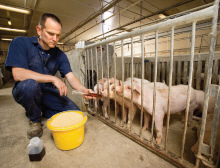



Fuel for Cars and Leftovers for Livestock
Biofuel research is not just a matter of finding the right type of biomass — maize soybean oil or other material — and converting it into fuel. Scientists must also find environmentally and economically sound uses for the co-products from biofuel production, write Alfredo Flores and Ann Perry of the USDA Agricultural Research Service.For example, producing a gallon of biodiesel from soybean oil also yields around two-thirds of a pound of crude glycerin. When this glycerin is refined to 99 per cent purity, it can be used in many products, including pharmaceuticals, foods, drinks, cosmetics and toiletries.

Livestock and poultry producers are looking for new sources of feed supplements to save costs and boost nutrition. “Several scientists have shown that it is possible to supplement pig diets with dried distiller’s grains, which remain after ethanol production.
Though this can result in equivalent animal productivity, it can also result in increased manure production – and higher levels of volatile organic compounds, which may increase odour emissions,” says animal nutritionist, Brian Kerr, who works at the ARS Swine Odor and Manure Management Research Unit at Ames, Iowa. “We decided to look at using the co-products from biodiesel production as feed supplements because no such data was available to the livestock industry.”
Dr Kerr partnered with animal scientist, William Dozier, formerly in the ARS Poultry Research Unit at Mississippi State and now with Auburn University, as well as Iowa State University colleague, Kristjan Bregendahl to see whether crude glycerin could be used to supplement livestock feed.
Glycerin Supplements Are a Success
Dr Kerr led studies that examined how crude glycerin feed supplements affected swine energy use. In five different experiments, he supplemented the diets of starter pigs and finisher pigs with different levels of crude glycerin.
Overall, these studies showed that the sample of crude glycerin contained an apparent metabolizable energy (AME) concentration of 3,207 calories per kilogram (kcal/kg). AME is a standard measure of energy used in nutritional studies.

Pigs fed the crude glycerin were able to digest it efficiently, and it provided them with a supply of caloric energy that basically equaled that of corn grain. A follow-up study showed no effects on weight, carcass composition, and meat quality in pigs fed diets containing 5 or 10 per cent crude glycerin from weaning to market weight.
Meanwhile, Drs Dozier and Bregendahl evaluated the use of glycerin supplements in poultry feed. They used 48 egg-laying hens and 1,392 broilers in four research studies.
After feeding four levels of crude glycerin to laying hens, Dr Bregendahl determined the AME in the crude glycerin to be 3,805 kcal/kg. He also compared feed consumption, egg production, egg weight and egg mass (calculated by multiplying egg production and egg weight) and found no significant differences between the four groups.
“Glycerin supplements were well utilized for egg production by the hens,” he says.
Dr Dozier, meanwhile, conducted three broiler studies. In his first study, young broilers consumed either a control diet with no glycerin supplementation or feed with a 6 per cent glycerin content. His results indicated that glycerin provided the 7- to 11-day-old broilers with an AME of 3,621 kcal/kg. Later research resulted in similar findings for older broilers.
Glycerin supplements at varying levels provided 21- to 24-day-old broilers with an AME of 3,331 kcal/kg and 42- to 45-day-old broilers with an AME of 3,349 kcal/kg.
Overall, the data indicates that crude glycerin is an excellent source of energy in swine and poultry rations and can be used without harming animal performance, carcass composition or meat quality.
“This research project has been a success so far,” says Dr Dozier. “We will have a total of six peer-reviewed papers from this research, and we’ve been invited to present the results at national and international nutrition conferences. But we still need additional research on how to handle glycerin as an alternative feedstuff for swine and poultry in integrated feed mills.”
He also notes that from a nutritional standpoint, this technology can serve as an alternative dietary energy source that could result in lower feed costs.
Crude glycerin does contain small amounts of methanol and salt, which could potentially limit its use as a feed supplement. Additional studies might be needed to assess how much methanol livestock can safely ingest in glycerin supplements, which would help regulators refine US standards for using crude glycerin in livestock feed.
But as US biodiesel production continues to boom, crude glycerin supplements could be a win-win situation for biodiesel producers and farmers alike.
“Swine and poultry producers are very interested in supplementing livestock feed with glycerin,” Dr Kerr notes. “This way, crops can be used for both biofuels and for livestock at the same time.”
March 2009








